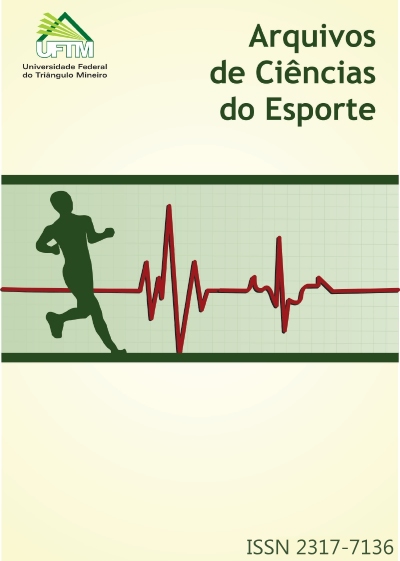Evidências da técnica de liberação miofascial no tratamento fisioterapêutico: revisão sistemática
DOI:
https://doi.org/10.17648/aces.v7n1.3504Palavras-chave:
liberação miofascial, modalidades de fisioterapia, reabilitaçãoResumo
Introdução: Frequentemente a fáscia, estrutura responsável pela transmissão de força tensional, está relacionada a queixas álgicas. Em decorrência a isso, a liberação miofascial é uma técnica amplamente utilizada na Fisioterapia, com o objetivo de mobilizar a fáscia, reduzindo aderências, gerando assim analgesia. Objetivo: analisar os métodos de liberação miofascial, verificando o nível de evidência destes. Métodos: Foi realizada uma busca nas bases de dados SciELO, PubMed e PEDro, utilizando as palavras-chaves: myofascial release, physical therapy, manual therapy, sendo os critérios de inclusão: Ensaios Clínicos Randomizados (ECR); idioma inglês ou português, e classificação maior ou igual a 7/10 (escala PEDro), sendo a busca realizada no período de 2008-2018. Resultados: Foram selecionados 132 ECR, dos quais foram excluídos: 27 duplicatas, 28 pela análise do título, 11 pós análise do resumo, 56 pela classificação inferior a 7 na escala PEDro e 3 em decorrência ao idioma, sendo dessa forma, selecionados 7 artigos para a revisão. Os estudos analisados no artigo compararam técnicas de liberação miofascial manual e instrumental, sendo a compressão isquêmica de pontos gatilhos a mais utilizada. Em comparativos entre as técnicas instrumentais, Foam Roll e Fascial Abrasion, a técnica utilizando o Foam Roll se mostrou menos efetiva. Conclusão: Em todas as suas formas de aplicação, a liberação miofascial se mostrou efetiva quanto ao alívio de dor e tensão.
Referências
Adstrum S, Hedley G, Schleip R, Stecco C, Yucesoy CA. Defining the fascial system. J Bodyw Mov Ther 2017; 21:173–177.
Schleip R, Jager H, Klingler W. What is ‘fascia’? A review of different nomenclatures. J Bodyw Mov Ther 2012; 16(4):496-502.
Chaitow L. Terapia Manual para disfunção fascial. Artmed, 2017.
Moccia D, Nackashi AA, Schilling R, Ward PJ. Fascial bundles of the infraspinatus fascia: anatomy, function and clinical considerations. J Anat 2016; 228(1):176-183.
Zullo A, Mancini FP, Scleip R, Wearing S, Yahia L, Klingler W. The interplay between fascia, skeletal muscle, nerves, adipose tissue, inflammation and mechanical stress in musculo-fascial regeneration. J Geront Geriatrics 2017; 65:271-283.
Langevin HM In: Audette JF, ailey A (eds) Integrative pain medicine. Humana Press, New York
Bennett RM, Friend R, Marcus D, Bernstein C, Han BK, Yachoui R, Deodhar A, Kaell A, Bonafede P, Chino A, Jones KD. Criteria for the Diagnosis of Fibromyalgia: Validation of the Modified 2010 Preliminary American College of Rheumatology Criteria and the Development of Alternative Criteria. Arthritis Care Res 2014; 66:1364-1373
Bigongiari A, Franciulli PM, Andrade e Souza F, Araujo RC. Análise da atividade eletromiográfica de superfície de pontos gatilhos miofasciais. Rev. Bras. Reumatol 2008; 48(6):319-324
Teixeira MJ. Dor, epidemiologia, fisiopatologia, avaliação, síndromes dolorosas e tratamento. São Paulo: Grupo Editorial Moreira Jr; 2001.
Barnes MF. The basic science of myofascial release: morphologic change in connective tissue. J Bodyw Mov Ther 1997; 1(4):231-238.
Manheim CJ. The myofascial release manual. Slack incorporated, 4th edition; 2008.
McKenney K, Elder AS, Elder C, Hutchins A. Myofascial release as a treatment for orthopaedic conditions: a systematic review. J Athl Train 2013; 48(4):522-7.
Kidd RF. Why myofascial release will never be evidence-based. Int. Musculoskelet. Med. 2013; 31(2): 55-56.
Zügel M, Maganaris CN, Wilke J, Jurkat-Rott K, Klingler W, Wearing SC, Findley T, Barbe MF, Steinacker JM, Vleeming A, Bloch W, Schleip R, Hodges PW. Fascial tissue research in sports medicine: from molecules to tissue adaptation, injury and diagnostics: consensus statement. Br J Sports Med 2018; 52 (23):1497.
Kim SJ, Lee JH. Effects of sternocleidomastoid muscle and suboccipital muscle soft tissue release on muscle hardness and pressure pain of the sternocleidomastoid muscle and upper trapezius muscle in smartphone users with latent trigger points. Medicine 2018; 97(36):e12133.
Rodriguez-Huguet M, Gil-Salú JL, Rodrigues-Huguet P, Cabrera-Afonso JR, Lomas-Vegas R. Effects of Myofascial Release on Pressure Pain Thresholds in Patients With Neck Pain: A Single-Blind Randomized Controlled Trial. Am J Phys Med Rehabil 2018; 97(1):16-22.
Arguisuelas MD, Lison JF, Sanches-zuriaga D, Martinez-Hurtado I, Domenech-Fernandez J. Effects of Myofascial Release in Nonspecific Chronic Low Back Pain: A Randomized Clinical Trial. Spine 2017; 42(9):627-634
Rodriguez-Fuentes I, De Toro FJ, Rodrigues-Fuentes G, de Oliveria IM, Meijide-Failde R, Fuentes-Boguete IM. Myofascial Release Therapy in the Treatment of Occupational Mechanical Neck Pain: A Randomized Parallel Group Study. Am J Phys Med Rehabil 2016; 95(7):507-15.
Markovic G. Acute effects of instrument assisted soft tissue mobilization vs. foam rolling on knee and hip range of motion in soccer players. J Bodyw Mov Ther 2015; 19(4):690-696.
Arroyo-Morales M, Olea N, Martinez MM, Hidalgo-Lozano A, Ruiz-Rodrigues C, Díaz-Rodrigues L. Psychophysiological Effects of Massage-Myofascial Release After Exercise: A Randomized Sham-Control Study. J Altern Complement Med 2008; 14(10):1223-1229.
Rezkallah S, Abdullah GA. Comparison between sustained natural apophyseal glides (SNAG’s) and myofascial release techniques combined with exercises in non specific neck pain. Physiother Pract Res 2018; 39(2):135-145.
Le Gal J, Begon M, Gillet B, Rogowski I. Effects of Self-Myofascial Release on Shoulder Function and Perception in Adolescent Tennis Players. J Sport Rehabil 2018; 27(6):530-535.
Downloads
Publicado
Edição
Seção
Licença
Deverá ser encaminhado, no momento da submissão, em documentos suplementares, as declarações de transferência de direitos autorais, responsabilidade e conflito de interesse. As declarações deverão ser elaboradas em documento único, conforme modelo disponibilizado aqui, e assinada pelo autor principal do manuscrito representando cada um dos autores.


